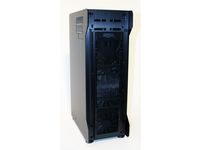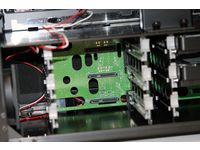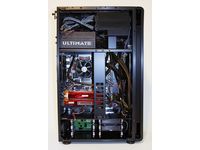Four Full Tower Cases From $150 To $600
ABS Canyon 695--Build And Installation
Build, Continued
Pop off one of the side panels and you’ll immediately see the thought process that went into designing the Canyon. Divided into three sections, the chassis attempts to isolate the power supply, the motherboard, and storage. Cooling in the power supply chamber is limited to the PSU’s own fan. The main chamber has three 140 mm fans blowing through it. And the lowest chamber is cooled by one 140 mm blower and two 80 mm coolers.
Sitting in my Aeron at full height, I could rest an elbow on the top of the Canyon. So, the power and reset buttons located on top of the case are actually conveniently located, as is the little metal door hiding USB, FireWire, eSATA, and audio connectivity. Not conveniently located, however, is the case’s fan controller switch sitting behind the aluminum front panel and under the fan filter. Hopefully you aren’t going to be changing fan speeds very often.
Overall, the build quality of ABS’ Canyon is great. It’s a work of art, crafted from aluminum. My only complaint is that the acoustic material applied to the chassis doors was applied in such a way as to cause bubbling, similar to what you’d see from an inexpensive auto tint job.
Installation
After spending $600 on a chassis, you probably want to bask in the building process, which is good since, despite its size, the Canyon isn’t exactly an easy case to work inside.
The hard drive backplane idea is an interesting one, but it limits capacity to standard 3.5” SATA drives. I’ve already seen a handful of complaints about VelociRaptors not working, though I don’t have any here to verify. Our Seagate and Samsung drives slid right in, but you still wind up attaching power and data cables to the backplane.
Get Tom's Hardware's best news and in-depth reviews, straight to your inbox.
As you can see, the power supply installs in the chamber above your motherboard. Though the Canyon is incredibly tall, it isn’t particularly deep. So, the 1 kW PC Power and Cooling PSU you’ll see in some of our other builds isn’t an option here—it runs right into the external drive bays. Even with Cooler Master’s smaller UCP 1100W installed, routing leads through the narrow gaps between each of the case’s levels is a task. Cable management is less an option here and more of a necessity.
Fortunately, massive dimensions work in the Canyon’s favor at least once. An eighth expansion slot and ample room at the bottom of the motherboard chamber mean a third double-wide graphics card will fit in our Asus Rampage II Extreme, hanging off the end of the board.
It’s also worth noting that this is another case just begging for a water cooling setup. There’s no reservoir fill hole like you’d find on the Cooler Master case, but there is plenty of room up top and four cutouts for hoses. More so than Cooler Master’s HAF, though, the ABS chassis is compartmentalized, sealed off, and insulated, suggesting that it’ll make a quieter candidate for air cooling.
Current page: ABS Canyon 695--Build And Installation
Prev Page ABS Canyon 695--Unpacking And Build Next Page Antec Twelve Hundred--Unpacking And Build-
Proximon Thank you Chris, another very useful article. Not enough case comparisons around, as I'm sure you realized.Reply
I'll be sure to add the HAF to my recommendation list. I hadn't before because I thought all the extra holes would hinder cooling more than help. The hole in the MB tray sounds especially useful.
I would have liked to see on of the Cosmos cases included, although I suspect they are simply quieter but hotter. -
malveaux Nice article.Reply
Though, I'm curious. 40db+ isn't whisper quiet. That's freak'n loud. What's up with calling it whisper quiet? -
Pei-chen The three cheaper cases are powerhouses but too big and overkill for most people including gamers. I think the Antec's Three Hundred ($60 a few weeks ago on Newegg) suits the need for most people. 750w PSU are usually enough for SLI/Crossfire so 1000w+ aren't needed.Reply -
malveaux I'm curious when they will start releaseing more cases that have more depth, so that they have more room for today's much larger videocard solutions.Reply -
kubes Ya I agree that case designers should consider making them have more depth. With this in mind though i'm sure vidoe card manufactors will only make their card even longer however.Reply -
antiacid Good article. Now it gives a procedure and template to test other cases as well. It'd be great to have a review of cases which could be "best of" a certain category (cooling, noise, ease of use, weight, etc). It would be even nicer if the results were put in bullet point form and were setup in a table like the ones used in hdd/video card tables. That would make it a lot easier to compare everything.Reply -
avatar_raq I do believe that all the cases available in the market these days are poorly designed especially when it comes to air flow. You may notice that front fans, rear fans, buttom, side and top panel fans -when combined- cause turbulence in air flow that reduces the overall air flow. That's why I buy a cheap $25 case and modded myself!!!Reply
I have so many innovations regarding case designs that I hope someone buys them and excutes them in reality!! -
avatar_raq Here is one of my ideas...Reply
To put it plainly: air needs to be moved in one direction, preferably from down-upwards, since hot air tends to go upward by nature and the hottest part of any system (that's the GFX cards) is located at the lower part..Hence a PSU mounted at the upper part of the case (with its 120-140mm fan), with another 120mm top-panel exhaust fan and two 120mm buttom intake fans will be by far more efficient than all the available cases. To achieve this efficincy I close any other holes (even the ones the manufacturer meant for ventilation) so the air enters the case only from the buttom fans where I put dust filters to minimize dust inside my case. Furthermore I use a case with long "legs" to minimize inhalation of the dust at my desk's surface.
To minimize noise: I use
1.low RPM silent fans.
2.rubber washers between the fans and the case to minimize vibration noise.
3.cover all the interior surfaces with a layer of an insulator, that can be as simple as sponge!!!
4.even design external air ducts that divert the exhausted air (which carries the interior noise) to the back. -
avatar_raq Fortunately many aftermarket CPU and GPU coolers helped me. They can be installed in a way that the fan moves the air upwards. There is evidence that the setup I suggested above reduces -though marginally- the power consumed by the CPU and GPU fans to reach thier designated rpm and increases the lifetime of these fans, since instead of meeting resistance, the one directional air flow helps them.Reply



